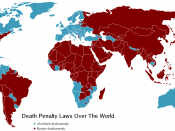The Death Penalty
The first known execution in the United States of America was of Daniel Frank, put to death in 1622 in the Colony of Virginia for the crime of theft. Since then the death penalty has almost always been a feature of the criminal justice system, first in the American colonies and then, after independence, in the U.S.
Legal challenges to the death penalty culminated in a 5 to 4 U.S. Supreme Court decision Furman v. Georgia in 1972, which struck down federal and state capital punishment laws permitting wide judgment in the request of the death penalty. Characterizing these laws as "arbitrary and capricious," the majority ruled that they constituted cruel and unusual punishment in violation of the Eighth Amendment to the U.S. Constitution and the due process guarantees of the Fourteenth Amendment. Only two of the justices in agreement in the decision (Justices Brennan and Marshall) declared capital punishment to be unconstitutional in all instances, however; other agreement by Justices Douglas, Stewart, and White focused on the unpredictability of the application of capital punishment, including the appearance of racial bias against black defendants.
In all, nine separate opinions - five canceling existing laws and four arguing for their retention -- were written by the nine Supreme Court justices spelling out their different views on what constituted the "cruel and unusual punishment" prohibited by the Eighth Amendment. More than 600 death row inmates who had been sentenced to death between 1967 and 1972 had their death sentences lifted as a result of Furman.
A big debate concerning the death penalty is determining the Constitutionality of the Death Penalty such as in the particular case, Furman v. Georgia. In Gregg v. Georgia of 1976, the death penalty was reinstated under an example of guided judgment. For about 14...



Add a few more facts in
I think you should have listed the ethical or religious reasons against the death penalty. You should have also compared the cost of the death penalty to the cost of a person sentenced to prison for life and where these dollars are coming out of which I believe is our tax money. Great essay but adding these in would have made it a little bit more better.
2 out of 2 people found this comment useful.